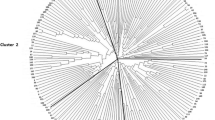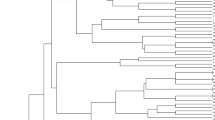Abstract
Fifty-two winter wheat (Triticum aestivum L.), nine spring wheat, and 20 spelt (Triticum spelta L.) lines representing part of the European breeding germplasm, were assayed for RFLPs (restriction fragment length polymorphisms) with 56 wheat DNA clones and two barley cDNA clones. Objectives of this study were to (1) determine the level of variation for RFLPs in the wheat and spelt breeding lines, (2) characterize the genetic diversity within the European winter wheat germplasm, and (3) evaluate the usefulness of RFLP markers for pedigree analysis and the grouping of wheat and spelt lines of various origins. Seventy-three of the 166 RFLP loci detected with 58 probes and one restriction enzyme were polymorphic for the 81 lines. The percentage of polymorphic loci was greatest for the B genome (58%) and smallest for the D genome (21%). Among the 81 lines, 271 different RFLP bands were detected. RFLP band frequencies of the winter wheat lines differed considerably (≥0.5) from those of the spring wheat lines at five loci, and from those of the spelt lines at 17 loci. Eight cultivars that had a major impact as progenitors on the development of improved winter wheat cultivars accounted for 93% of the observed RFLP bands in winter wheat. Genetic distance (GD) estimates between two lines ranged between 0.01 and 0.21. Mean GD estimates within winter wheat (0.083), within spring wheat (0.108) and within spelt (0.096) were smaller than between spring and winter wheat (0.114), and greatest between winter wheat and spelt (0.132) and spring wheat and spelt (0.148). Principal coordinate analysis performed on GD estimates revealed a clear separation of wheat and spelt germplasm. Novel spelt lines with various proportions of wheat germplasm were positioned between wheat and traditional spelt lines. The spring wheat lines formed a distinct group at the periphery of the distribution of the winter wheat lines. Subgroupings of the winter wheat lines according to the cluster analysis were in good agreement with their origin, and lines with common ancestors were grouped together.
Similar content being viewed by others
References
Anderson JA, Churchill GA, Autrique JE, Tanksley SD, Sorrells ME (1993) Optimizing parental selection for genetic linkage maps. Genome 36:181–186
Boppenmaier J, Melchinger AE, Brunklaus-Jung E, Geiger HH, Herrmann RG (1992) Genetic diversity for RFLPs in European maize inbreds. I. Relation to performance of flintxdent crosses for forage traits. Crop Sci 32:895–902
Botstein D, White RL, Skolnik M, Davis RW (1980) Construction of a genetic linkage map in man using restriction fragment length polymporphisms. Am J Hum Genet 32:314–331
Chao S, Sharp PJ, Worland AJ, Warham EJ, Koebner RMD, Gale MD (1989) RFLP-based genetic map of wheat homoeologous group 7 chromosomes. Theor Appl Genet 78:495–504
Chen PD, Liu DJ, Pei GZ, Qi LL, Huang L (1988) The chromosome constitution of three endemic hexaploid wheats in western China. In: Miller TE, Koebner RMD (eds) 7th Int Wheat Symp. IPSR, Cambridge, England, pp 75–80
Devos KM, Gale MD (1992) The use of random amplified polymorphic DNA markers in wheat. Theor Appl Genet 84:567–572
Dweikat I, Mackenzie S, Levy M, Ohm H (1993) Pedigree assessment using RAPD-DGGE in cereal crop species. Theor Appl Genet 85:497–505
Feinberg AP, Vogelstein B (1983) A technique for radiolabelling DNA restriction endonuclease fragments to high specific activity. Anal Biochem 132:6–13
Gale MD, Chao S, Sharp PJ (1990) RFLP mapping in wheat —progress and problems. In: Gustafson JP (ed) Gene manipulation in plant improvement II. Plenum Press, New York, pp 353–363
Gill KS, Lubbers EL, Gill BS, Raupp WJ, Cox TS (1991) A genetic linkage map of Triticum tauschii (DD) and its relationship to the D genome of bread wheat (AABBDD). Genome 34:362–374
Gower JC (1972) Measures of taxonomic distance and their analysis. In: Weiner JS, Huizinga J (eds) The assessment of population affinities in man. Clarendon Press, Oxford, pp 1–24
Graner A, Siedler H, Jahoor A, Herrmann RG, Wenzel G (1990) Assessment of the degree and the type of restriction fragment length polymorphism in barley (Hordeum vulgare). Theor Appl Genet 80:826–832
Hart GE, Gale MD, McIntosh RA (1993) Linkage maps of Triticum aestivum (hexaploid wheat, 2n=42, genomes A, B and D) and T. tauschii (2n=14, genome D). In: Hoisington D, McNab A (eds) Progress in genome mapping of wheat and related species. Proc 3rd Public Workshop Int Triticeae Mapping Initiative. El Batan, Mexico, DF: CIMMYT, pp 32–46
He S, Ohm H, Mackenzie S (1992) Detection of DNA sequence polymorphisms among wheat varieties. Theor Appl Genet 84:573–578
Hoeser K, Wenisch K, Oppitz K (1975) Die Entwicklung der wichtigsten deutschen Winterweizen-Marktsorten und ihr genetischer Hintergrund. Berichte über die Arbeitstagung der Arbeitsgemeinschaft der Saatzuchtleiter, Gumpenstein, pp 31–49
Kam-Morgan LNW, Gill BS (1989) DNA restriction fragment length polymorphisms: a strategy for genetic mapping of the D genome of wheat. Genome 32:724–732
Liu YG, Mori N, Tsunewaki K (1990) Restriction fragment length polymorphism (RFLP) analysis in wheat. I. Genomic DNA library construction and RFLP analysis in common wheat. Jpn J Genet 65:367–380
Liu YG, Tsunewaki K (1991) Restriction fragment length polymorphism (RFLP) analysis in wheat. II. Linkage maps of the RFLP sites in common wheat. Jpn J Genet 66:617–633
Liu YG, Ikeda TM, Tsunewaki K (1992) Moderately repeated, dispersed, and highly variable (MRDHV) genomic sequences of common wheat usable for cultivar identification. Theor Appl Genet 84:535–543
Lubbers EL, Gill KS, Cox TS, Gill BS (1991) Variation of molecular markers among geographically diverse accessions of Triticum tauschii. Genome 34:354–361
Lupton FGH (1987) History of wheat breeding. In: Lupton FGH (ed) Wheat breeding. Chapman and Hall Ltd., London, New York, pp 51–70
Mac Key J (1954) Neutron and X-ray experiments in wheat and a revision of the speltoid problem. Hereditas 40:65–180
Metzlaff M, Troebner W, Baldauf F, Schlegel R, Cullum J (1986) Wheat specific repetitive DNA sequences — construction and characterization of four different genomic clones. Theor Appl Genet 72:207–210
Monte JV, McIntyre CL, Gustafson JP (1993) Analysis of phylogenetic relationships in the Triticeae tribe using RFLPs. Theor Appl Genet 86:649–655
Odenbach W (1985) 1.1.7. Abstammungslinien in der deutschen Winterweizenzüchtung. In: Hoffmann W, Mudra A, Plarre W (eds) Lehrbuch der Züchtung landwirtschaftlicher Kulturpflanzen. Band 2, 2nd edn., Paul Parey, Berlin Hamburg, pp 64–67
Rohlf FJ (1989) NTSYS-pc numerical taxonomy and multivariate analysis system. Version 1.5. Exeter Publishing Ltd., Setauket, New York
SAS Institute (1988) SAS procedure guide for personal computers. Release 6.03. SAS Institute, Cary, North Carolina
Schmidt T, Boblenz K, Metzlaff M, Kaemmer D, Weising K, Kahl G (1993) DNA fingerprinting in sugar beet (Beta vulgaris) —identification of double-haploid breeding lines. Theor Appl Genet 85:653–657
Sneath PHA, Sokal RR (1973) Numerical taxonomy. WH Freeman and Co., San Fransisco
Vaccino P, Accerbi M, Corbellini M (1993) Cultivar identification in T. aestivum using highly polymorphic RFLP probes. Theor Appl Genet 86:833–836
Vierling RA, Nguyen HT (1992) Use of RAPD markers to determine the genetic diversity of diploid wheat genotypes. Theor Appl Genet 84:835–838
Weining S, Langridge P (1991) Identification and mapping of polymorphisms in cereals based on the polymerase chain reaction. Theor Appl Genet 82:209–216
Williams JGK, Kubelik AR, Livak KJ, Rafalski JA, Tingey SV (1990) DNA polymorphisms amplified by arbitrary primers are useful as genetic markers. Nucleic Acids Res 18:6531–6535
Winzeler H, Rüegger A (1990) Dinkel: Renaissance einer alten Getreideart. Landwirtschaft Schweiz 3:503–511
Winzeler H, Schmid JE, Winzeler M, Rüegger A (1991) Neue Aspekte der Dinkelzüchtung (Triticum spelta L.) in der Schweiz. 2. Hohenheimer Dinkelkolloquium, Universität Hohenheim, pp 11–25
Zeven AC, Zeven-Hissink NC (1976) Genealogies of 14,000 wheat varieties. Issued by: The Netherlands Cereals Centre-NGC, Wageningen and The International Maize and Wheat Improvement Center-CIMMYT, Mexico
Author information
Authors and Affiliations
Additional information
Communicated by G. Wenzel
Rights and permissions
About this article
Cite this article
Siedler, H., Messmer, M.M., Schachermayr, G.M. et al. Genetic diversity in European wheat and spelt breeding material based on RFLP data. Theoret. Appl. Genetics 88, 994–1003 (1994). https://doi.org/10.1007/BF00220807
Received:
Accepted:
Issue Date:
DOI: https://doi.org/10.1007/BF00220807




